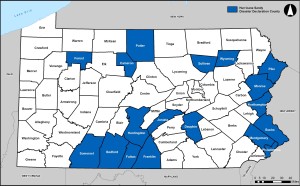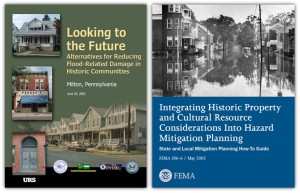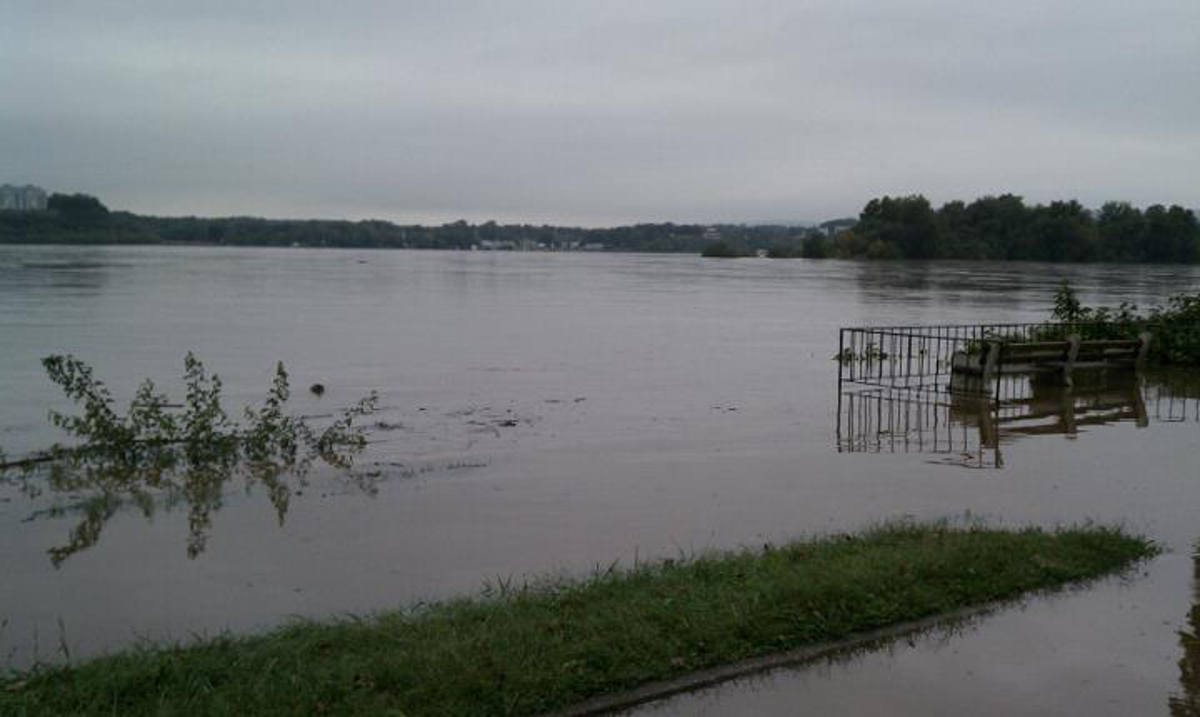The Pennsylvania State Historic Preservation Office (PA SHPO) is pleased to announce that it has begun moving forward on an exciting and historic new initiative to continue through 2017.
Special funding awarded by the National Park Service following Hurricane Sandy has enabled the PA SHPO to assist select counties with prioritizing their communities’ historic properties during the pre-disaster planning process—to help ensure they are better protected the next time a major disaster strikes the Keystone State.
As part of the federal Disaster Relief Appropriations Act of 2013 (P.L. 113-2), designed to streamline disaster assistance related to Hurricane Sandy, the National Park Service awarded more than $7.6 million in grants to eight states. Early last year, the Pennsylvania Historical and Museum Commission (“PHMC”) was awarded $1.5 million to help stabilize and repair historic properties damaged by Hurricane Sandy and undertake disaster-related planning initiatives. The greatest portion of these awarded funds have been reserved for the latter; of which includes assisting select counties with updating their state and federally approved hazard mitigation plans to include historic property considerations. This will be achieved in two phases:
- Identifying selected counties’ most vulnerable historic properties through a focused and publicly influenced reconnaissance-level survey and the analysis of resources existing in the state’s historic resource inventory; and
- Developing strategies to protect these local historic assets during, and in the aftermath of, future natural and man-made disasters, and integrating those strategies into selected counties’ FEMA-approved Hazard Mitigation Plans.
 Several counties have been invited to participate in this innovative new initiative to integrate historic preservation and hazard mitigation strategies. Those counties were selected based upon their requirement to update their hazard mitigation plan by 2017 in cooperation with the Pennsylvania Emergency Management Agency (PEMA) and Federal Emergency Management Agency (FEMA). Additionally, the counties were required to be among the 18 counties that received a Presidential Disaster Declaration during Hurricane Sandy.
Several counties have been invited to participate in this innovative new initiative to integrate historic preservation and hazard mitigation strategies. Those counties were selected based upon their requirement to update their hazard mitigation plan by 2017 in cooperation with the Pennsylvania Emergency Management Agency (PEMA) and Federal Emergency Management Agency (FEMA). Additionally, the counties were required to be among the 18 counties that received a Presidential Disaster Declaration during Hurricane Sandy.
In the wake of several major disaster events in recent years including hurricanes Irene and Sandy and tropical storm Lee, the PHMC has identified a need to develop more detailed guidance with regard to specific disaster response and mitigation activities as they relate to historic communities. To date, among the most common strategies used by PEMA and FEMA to prevent or lessen the severity of future disaster impacts have been to acquire and demolish hazard-prone buildings to remove them from harm’s way. Such buildings may be located in early settlement areas and include those listed in or eligible for the National Register of Historic Places as well as buildings of an historic nature that remain undocumented. PEMA and FEMA have recently acknowledged the lack of adequate information about these and other historic and cultural resources in the state- and county-level hazard mitigation plans. These agencies and the PHMC have also begun to recognize the benefits of taking a proactive approach by considering a community’s historic properties pre-disaster—in the planning stages—rather than taking a more reactive approach that focuses on these assets only during the disaster recovery phase.
The federal Disaster Mitigation Act of 2000 (PL-106-390), which requires local jurisdictions to have hazard mitigation plans to be eligible for federal assistance following a disaster event, encourages communities to continuously strive to improve their plans and resulting mitigation actions, and emphasizes public participation and coordination among state and local agencies. This type of collaboration is critical to reducing disaster-related damage to historic properties and other community assets and ensuring that communities can not only survive, but also thrive in the wake of a devastating event. A coordinated effort by the PHMC, PEMA, county and municipal agencies, and the general public to identify and take measures to protect counties’ most cherished historic assets will result in a more comprehensive approach to disaster planning as well as an improved and more complete update to each county’s hazard mitigation plan.
 The integration of historic preservation goals into the counties’ hazard mitigation plans will generally follow FEMA’s guidance Integrating Historic Property and Cultural Resource Considerations Into Hazard Mitigation Planning: State and Local Mitigation Planning How-To Guide (FEMA 386-6), published in 2005. To date, only a few localities nationwide are known to have integrated historic property considerations into their hazard mitigation plans according to this guidance. In 2011, the tornado-prone city of Tulsa, Oklahoma, was believed to be the first municipality nationally to have done such, and the City of Annapolis, Maryland, susceptible to sea level rise and coastal floods, is currently in the process of planning for its historic district according to FEMA’s prescribed methodology. While this particular guidance has not yet been applied in Pennsylvania, it is important to note that the Keystone State did indeed help to lay the foundation for the integration of historic preservation and hazard mitigation in the United States with its 2002 study Looking to the Future: Alternatives for Reducing Flood-Related Damage in Historic Communities. This pilot study, focused on the Borough of Milton in Northumberland County, was funded by FEMA and in many ways marks the beginning of a partnership between FEMA, PEMA, and the PA SHPO that continues to grow today. The study also provided a model for FEMA’s 2005 integration guide. Elements of the Milton flood study could be replicated for the purposes of the Disaster Planning for Historic Properties initiative, and for a variety of natural hazards beyond flooding.
The integration of historic preservation goals into the counties’ hazard mitigation plans will generally follow FEMA’s guidance Integrating Historic Property and Cultural Resource Considerations Into Hazard Mitigation Planning: State and Local Mitigation Planning How-To Guide (FEMA 386-6), published in 2005. To date, only a few localities nationwide are known to have integrated historic property considerations into their hazard mitigation plans according to this guidance. In 2011, the tornado-prone city of Tulsa, Oklahoma, was believed to be the first municipality nationally to have done such, and the City of Annapolis, Maryland, susceptible to sea level rise and coastal floods, is currently in the process of planning for its historic district according to FEMA’s prescribed methodology. While this particular guidance has not yet been applied in Pennsylvania, it is important to note that the Keystone State did indeed help to lay the foundation for the integration of historic preservation and hazard mitigation in the United States with its 2002 study Looking to the Future: Alternatives for Reducing Flood-Related Damage in Historic Communities. This pilot study, focused on the Borough of Milton in Northumberland County, was funded by FEMA and in many ways marks the beginning of a partnership between FEMA, PEMA, and the PA SHPO that continues to grow today. The study also provided a model for FEMA’s 2005 integration guide. Elements of the Milton flood study could be replicated for the purposes of the Disaster Planning for Historic Properties initiative, and for a variety of natural hazards beyond flooding.
In addition to assisting select counties with integrating historic property considerations into their hazard mitigation plans, the PA SHPO and Disaster Planning for Historic Properties project teams will undertake studies to explore the complex issues surrounding several common mitigation strategies (i.e., elevating flood-prone buildings) and their impacts on the integrity of local historic properties and districts. The goal of these projects will not only be to articulate the problems, but identify solutions that can be applied to various types of geographic locations (i.e., flood plains), hazard scenarios, and historic building types. Goals include: identifying and developing best practices for addressing future disasters to ensure outcomes are the least intrusive for historic properties; employing a variety of techniques for different building types; and considering alternatives for reducing damages from a various types of disasters—including, but not limited to, floods, severe wind events, and fires. Recommendations for historic properties resulting from these studies will be integrated into the counties’ hazard mitigation plans, and in many cases will draw from national and international best practices.
Stay tuned to find out which counties will participate in the Disaster Planning for Historic Properties Initiative, and to follow progress on this cutting-edge project!
This material is based upon work assisted by a grant from the U.S. Department of the Interior, National Park Service. Any opinions, findings, and conclusions or recommendations expressed in this material are those of the author(s) and do not necessarily reflect the views of the Department of the Interior.
Comment Policy
PHMC welcomes and encourages topic-related comments on this blog. PHMC reserves the right to remove comments that in PHMC’s discretion do not follow participation guidelines.
Commenters and Comments shall be related to the blog post topic and respectful of others who use this site.
Commenters and Comments shall not: use language that is offensive, inflammatory or provocative (this includes, but is not limited to, using profanity, obscene, or vulgar comments); disparage other commenters or people; condone illegal activity; identify the location of known or suspected archeological sites; post personal information in comments such as addresses, phone numbers, e-mail addresses or other contact details, which may relate to you or other individuals; impersonate or falsely claim to represent a person or an organization; make any commercial endorsement or promotion of any product, service or publication.
If you would like to comment on other topics not related to this blog post but related to PHMC, please fill out the PHMC Contact Us Form.

Great news and I look forward to hearing more about this important project.
good post !